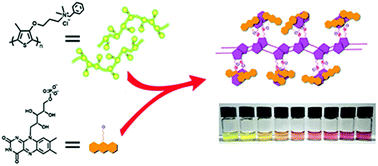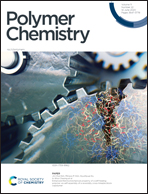Self-assembly of flavin mononucleotide and a cationic polythiophene in aqueous media: spectroscopic studies and sensing applications†
Abstract
Flavin mononucleotide (FMN) is well known as a cofactor of riboflavin and plays key roles in metabolisms. Self-assembly is one of the most important approaches for maintaining the biological functions of FMN. In this work, a supramolecular self-assembly nano-system driven by non-covalent interactions between a water-soluble polythiophene (PMT-1) and FMN is constructed in 100% aqueous solution. In this system, π-stacked nano-aggregates have been formed and the self-assembly process of PMT-1 and FMN has been explored through UV-Vis, fluorescence, and circular dichroism (CD) spectroscopy. The synergistic effect of non-covalent interactions containing electrostatic, hydrophobic and π–π interactions is proposed to account for the formation of PMT-1/FMN nano-superstructures. Furthermore, colorimetric responses of PMT-1 promote the sensing applications of this approach for the rapid and visual detection of FMN. It features wide detection range, fast response, high sensitivity and selectivity. The LOD in buffer and actual sample could be as low as 1.1 and 32 nM, respectively.



 Please wait while we load your content...
Please wait while we load your content...